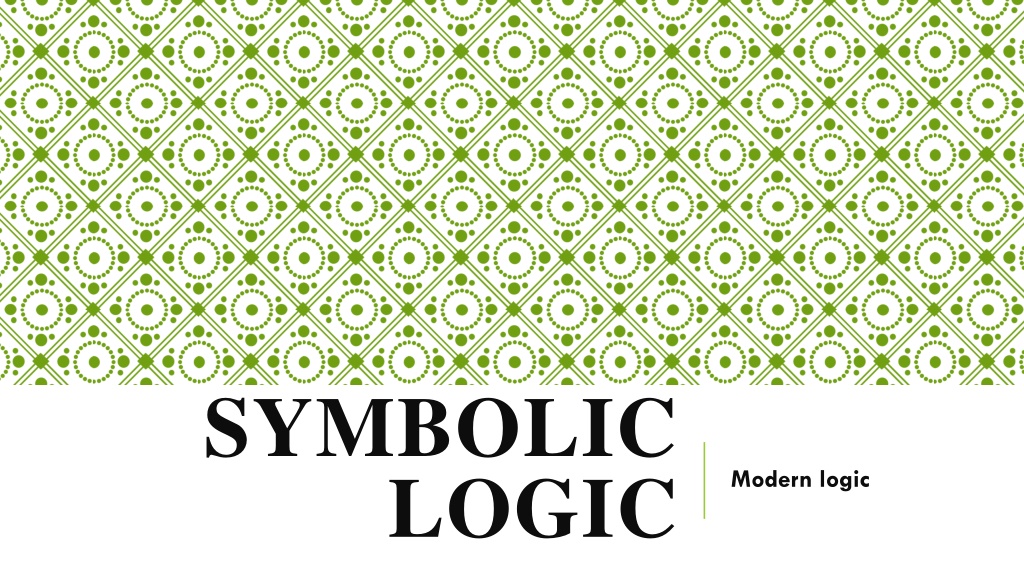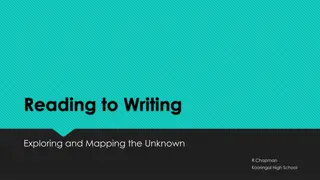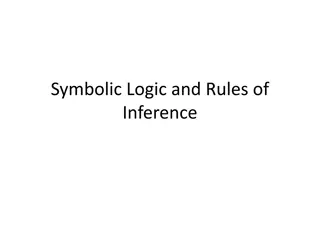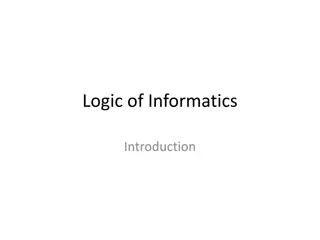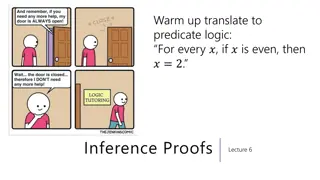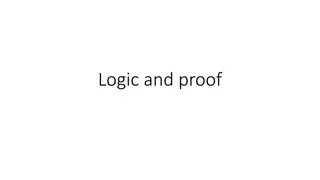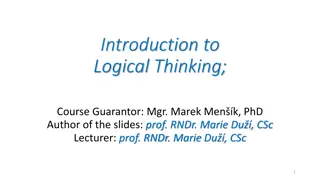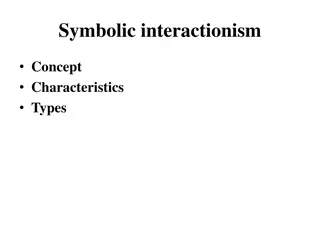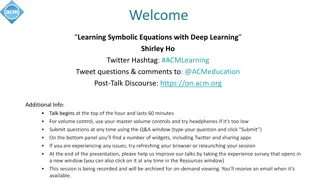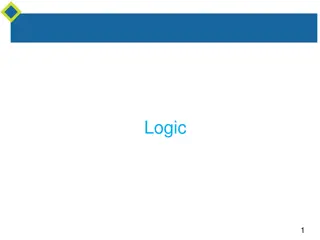Understanding Symbolic Logic: A Modern Approach
Delve into the world of symbolic logic where traditional and modern approaches differ. Learn how symbolic languages help overcome challenges with natural languages, leading to a clearer understanding of deductive reasoning through the analysis of premises, conclusions, compound statements, and logical symbols like conjunction. Explore the evolution from Aristotelian logic to modern Symbolic Logic and discover the significance of using symbols for efficient reasoning.
Download Presentation

Please find below an Image/Link to download the presentation.
The content on the website is provided AS IS for your information and personal use only. It may not be sold, licensed, or shared on other websites without obtaining consent from the author. Download presentation by click this link. If you encounter any issues during the download, it is possible that the publisher has removed the file from their server.
E N D
Presentation Transcript
SYMBOLIC LOGIC Modern logic
To fully understand deductive reasoning we need a general theory of deduction to 1. Explain the relations between premises and conclusions. 2. Provide techniques for discriminating between valid and invalid.
Early on, we examined classical logic (Aristotelian logic): Square + Syllogisms We now consider modern logic: Symbolic Logic
These two systems have similar aims, but proceed in very different ways. Modern logic uses an artificial symbolic language. Why? Because natural languages like English often use vague words, double meaning, metaphors, etc.
Traditional logic is not versatile enough. A symbolic language overcomes these issues. Think about multiplying Roman numerals: CXIII multiplied by IV. 113 x 4 is much easier to multiply, right? Symbolic logic, by using symbols, makes this task much easier.
Arguments may contain compound statements. Statements are either simple or compound. Simple Statement: A statement that contains no other statement as a component. Example: Charlie is tall is a simple subject-predicate statement.
Compound Statement: A statement that contains one or more statements as components. Example: Charlie is tall and Charlie is intelligent is a compound statement. Two statement in one: 1. Charlie is tall and 2. Charlie is intelligent. This particular statement is conjoined by the word and but there are different compound statements, each of which requires its own logical symbol.
CONJUNCTION (AND) In the example just given, the compound statement is formed by way of conjunction, by using the word and . The compound statement, Charlie is tall and Charlie is intelligent is a conjunction. In a conjunction the first conjunct is Charlie is tall and the second conjunct is Charlie is intelligent .
The symbol we use to connect statements conjunctively is the symbol + Thus the previous conjunction can be written as Charlie is tall + Charlie is intelligent
The point is to translate statements into symbols to express arguments more simply and test their validity by constructing a truth table. Just as a preview: The compound statement above may be a premise to an argument: Charlie is tall and Charlie is intelligent. Therefore, Charlie is intelligent.
This argument can be stated symbolically by using a letter to stand for each conjunct like this: T = Charlie is tall. and = + I = Charlie is intelligent. Then rewrite the argument symbolically (the three dots mean therefore ): T + I I
Truth Value Since every statement is either true or false, we say that every statement has a truth value. The entire compound statement also has a truth value. The truth value of a compound statement is determined by the truth value of its components: if both its conjuncts are true, the conjunction is true, otherwise it is false.
For that reason, a conjunction is said to be a truth-functional compound statement. And its conjuncts are truth-functional compounds. And the symbol + is a truth-functional connective.
Given two statements there are only 4 possible sets of truth values: Let s take our Charlie argument to illustrate: T = Charlie is tall. I = Charlie is intelligent. When T is true and I is true = T + I is true. When T is false and I is true = T + I is false. When T is true and I is false = T + I is false. When T is false and I is false = T + I is false. in other words, a conjunction is true if and only if both its conjuncts are true.
Another way to symbolize it is construct a truth table. T I T + I T T T F T F T F F F F F
NEGATION (NOT) The negation of a statement is indicated with the word not . Negating a statement also can be done by prefixing a sentence by it is false that Modern logicians use the symbol minus - This is an easy one: If a statement is true, then its negation must be false, and vice versa.
EXAMPLE: P = Popcorn is good P = Popcorn is not good P -P T F F T
DISJUNCTION (OR) Each statement is called disjunct. The symbol used is the lower case letter v T I T v I T T T F T T T F T F F F
CONDITIONAL STATEMENT (IFTHEN) An if then statement is a conditional statement. Example: If I graduate, then I will get a job. the first statement is the antecedent, the second is the consequent. The symbol used is the lazy U (or horseshoe)
Any conditional statement is false if its antecedent is true and its consequent false. T F = F T I T I T T T F T T T F F F F T
MATERIAL EQUIVALENCE (IF AND ONLY IF) Two statements are materially equivalent just if they have the same truth value. The connective used is the three-bar sign, if and only if often iff T I T I T T T F T F T F F F F T
Just like in normal language, in symbolic logic we need punctuation. Consider the following: The teacher said John is intelligent. vs. The teacher, said John, is intelligent. by inserting commas to a sentence we can create a totally different meaning. Even in math: 2x3+5 vs. 2x (3+5) In symbolic logic we use parentheses, brackets, braces, etc.to create different meanings.
For example, if I say, It is not true that if Max runs, then Bill swims and John fences. I mean If Max runs, then Bill swims and John fences is false. (The entire conditional statement is false) But notice that Bill swims and John fences is a conjunction. And this conjunction is the consequent of the entire conditional statement. To translate the statement into symbols, we may underline full statements and circle connectives: it is not true that if Max runs then Bill swims and John fences. First step: Second step: Assign an uppercase letter to each statement. Max runs = M Bill Swims = B John Fences = F
Third step: rewrite the sentence using symbols. it is not true that if Max runs then Bill swims and John fences. B - M + F -M B+F Fourth step: use parenthesis, brackets, etc. if needed. -[M (B+F)]
it is not true that if Max runs and Bill swims then John fences, and it s not true that Max runs or Bill swims. Max runs = M Bill swims = B John fences = F it is not true that if M and B then F, and it s not true that M or B. -M+B F + - M v B - (M+B) F + - (M v B) - [(M+B) F] + - (M v B)
If the President vetoes the bill or if people protest, then the chances of passing this year s new tax amendment are Congress balks and the not good. The President vetoes the bill = V Congress balks = C The people protest = P The chances of passing this year s new tax amendment are good = G Notice I did not include not because it is a negation and I want only the simple sentence.
If V or if C and P, then not G C and P should be grouped together, so (C + P) If V or if (C and P), then not G Now, the whole statement is a conditional: If V or if (C and P) is the antecedent. then not G is the consequent. Therefore, they should be connected with the horseshoe
If V or if (C and P) not G To further indicate that the antecedent and consequent are separated we use brackets (because we already used parentheses). [If V or if (C and P)] not G Now we need to get rid of words and convert them into connectives: [V v (C + P)] G
Its not true that If I am innocent and do not have an alibi, then I go to jail. It is not true that if I + - A then J I am innocent = I I have an alibi = A I go to jail = J It is not true that (if I + - A) then J - (I + - A) J - [(I + - A) J]
